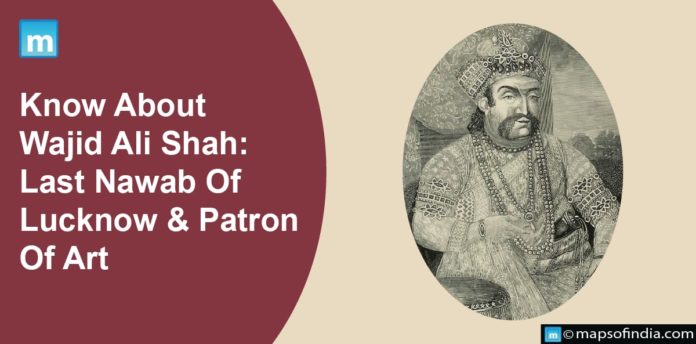The historical region of Awadh bestowed upon the heritage of India a great many delights. From a variety of Rotis, enthralling artistry, the best flavors, and, above all, great leaders, the legacy of Awadh is exemplary. Wajid Ali Shah was one such gem from the Auburn aisles of Awadh. The eleventh and the last of Nawab to adorn the throne of Awadh was more than just a leading figure.
Background
Crowned as the Nawab of Awadh in 1882, Ali Shah ruled the territory for nine years until he was exiled by the East India Company in 1856 for misgovernance and debauchery. But that was the Company’s version of annexing the Kingdom of Awadh into the British fold. However, in truth, Nawab attempted to introduce reforms to his administration that feared the Britishers into annexing the territory.
The Nawab was a man of many talents, a poet, playwright, dancer, and profound patron of arts. He is also credited for contributing to the revival of the Indian dance form Kathak. His time spent as Nawab is perfused with generosity and admiration for artistic valor. However, his stay in Calcutta distinctly brought forth his individual temperament and unique persona of Wajid Shah Ali.
Exile to Kolkata
After the annexation of Awadh, the Nawab and his family weres exiled to Garden Reach in the then Calcutta. However, upon the arrival, the queen and her son left for England, but the Nawab chose to stay in his assigned residence. After the revolt of 1857, he was imprisoned under the periphery of Fort William. He was released after two years. After the newly earned, he steadily established a look-alike kingdom for himself to satiate the deposition of his inner king. He also somehow managed to get Britishers to finance him for the same.
From awadh’s Court to Court of Garden Reach
Garden Reach back then was a suburban area of Kolkata, a place mainly serving as a routine abode for high-ranking Company officials. During his time in Garden Reach, the Nawab was compensated with a pension worth Rs 1 Lakh and a residence in Bungalow Number 11.
Many people from the court of Lucknow followed their Nawab to the city of Kolkata. This bunch included his wives, children, artisans, entertainers, cooks, ministers, and others. These folks already became regular residents of Garden Reach, which called for renting two more bungalows. The charm of Wajid Ali Shah was such that he again managed to talk Britishers into buying him all three adjoining bungalows. There began his foundation for building the caricature of the court and making a royal living in the distinct land of Kolkata. The valor and enchantment of the happening Lucknow court was revived in the mansions of Garden Reach. The Nawab organized elaborate events that permeated the royal vibrance of poetry, dance, and music. Courtesy of this rejuvenation of art, Bengal Kathak and biryani-with-potato are popular even today.
The Nawab who never stopped being one
The unfair annexation of Nawab’s kingdom could be an important factor for why Britishers always rescued him from any trouble and played at some of his whims. However, it was the strong-willed and charismatic personality of Wajid Ali Shah that rubbed on even the Company officials. It was his adamant nature of not adhering to the reduced nature of his station and acting exactly as he was born to act, like a Nawab. The archives also tell us that he persistently wrote to Queen Victoria and senior officials at a time that distinctly stood him out as not a commoner but a King.




